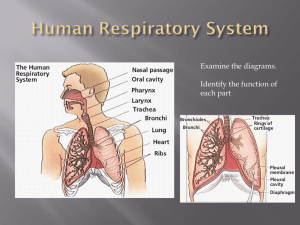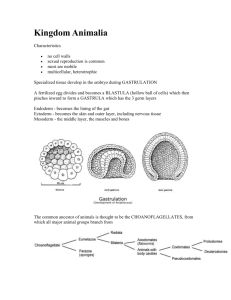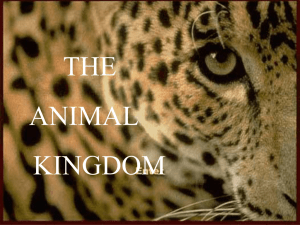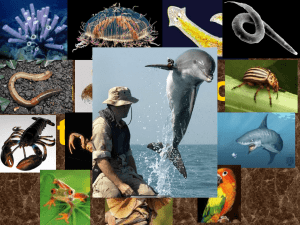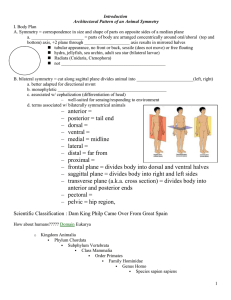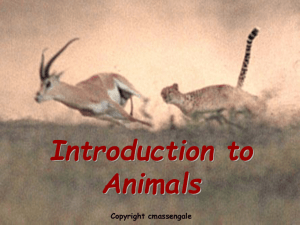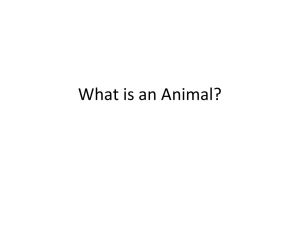Zoology Semester Exam
advertisement
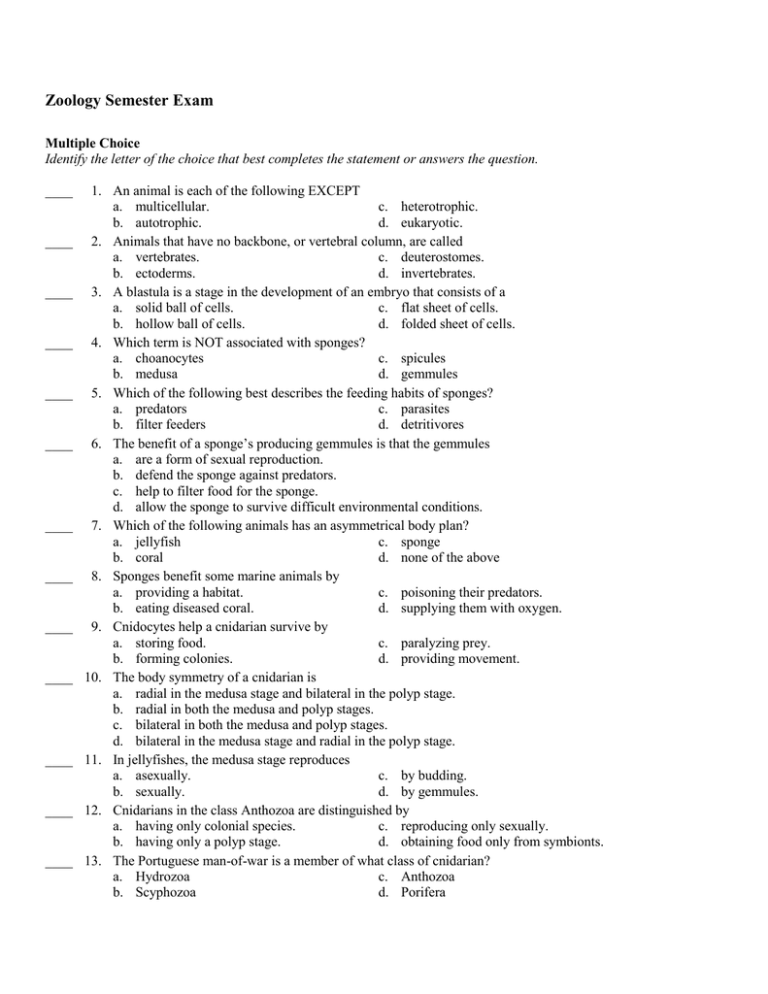
Zoology Semester Exam Multiple Choice Identify the letter of the choice that best completes the statement or answers the question. ____ ____ ____ ____ ____ ____ ____ ____ ____ ____ ____ ____ ____ 1. An animal is each of the following EXCEPT a. multicellular. c. heterotrophic. b. autotrophic. d. eukaryotic. 2. Animals that have no backbone, or vertebral column, are called a. vertebrates. c. deuterostomes. b. ectoderms. d. invertebrates. 3. A blastula is a stage in the development of an embryo that consists of a a. solid ball of cells. c. flat sheet of cells. b. hollow ball of cells. d. folded sheet of cells. 4. Which term is NOT associated with sponges? a. choanocytes c. spicules b. medusa d. gemmules 5. Which of the following best describes the feeding habits of sponges? a. predators c. parasites b. filter feeders d. detritivores 6. The benefit of a sponge’s producing gemmules is that the gemmules a. are a form of sexual reproduction. b. defend the sponge against predators. c. help to filter food for the sponge. d. allow the sponge to survive difficult environmental conditions. 7. Which of the following animals has an asymmetrical body plan? a. jellyfish c. sponge b. coral d. none of the above 8. Sponges benefit some marine animals by a. providing a habitat. c. poisoning their predators. b. eating diseased coral. d. supplying them with oxygen. 9. Cnidocytes help a cnidarian survive by a. storing food. c. paralyzing prey. b. forming colonies. d. providing movement. 10. The body symmetry of a cnidarian is a. radial in the medusa stage and bilateral in the polyp stage. b. radial in both the medusa and polyp stages. c. bilateral in both the medusa and polyp stages. d. bilateral in the medusa stage and radial in the polyp stage. 11. In jellyfishes, the medusa stage reproduces a. asexually. c. by budding. b. sexually. d. by gemmules. 12. Cnidarians in the class Anthozoa are distinguished by a. having only colonial species. c. reproducing only sexually. b. having only a polyp stage. d. obtaining food only from symbionts. 13. The Portuguese man-of-war is a member of what class of cnidarian? a. Hydrozoa c. Anthozoa b. Scyphozoa d. Porifera ____ 14. What are animals that have a backbone called? a. invertebrates c. vertebrates b. heterotrophs d. eukaryotes ____ 15. Which of the following are trends in animal evolution as animals become more complex? a. having a body cavity c. high levels of cell specialization b. bilateral body symmetry d. all of the above ____ 16. When an animal zygote undergoes a series of divisions to form a hollow ball of cells, it is called a(an) a. blastula. c. ectoderm. b. spicule. d. anus. ____ 17. What is an animal called whose mouth is formed from the blastopore? a. protostome c. mesoderm b. deuterstome d. archaeocyte ____ 18. An animal that has distinct left and right sides shows a. radial symmetry. c. several planes of symmetry. b. segmentation. d. bilateral symmetry. ____ 19. Unlike plants, sponges are a. heterotrophic. c. unicellular. b. autotrophic. d. photosynthetic. ____ 20. Sponges reproduce sexually through a process called a. cephalization. c. radial symmetry. b. internal fertilization. d. budding. ____ 21. Which of the following is a characteristic of cnidarians? a. bilateral symmetry c. radial symmetry b. cephalization d. internal fertilization ____ 22. Cnidarians have two basic body types, a medusa and a(an) a. larva. c. polyp. b. tentacle. d. osculum. ____ 23. The nerve cells of cnidarians make up a(an) a. brain. c. hydrostatic skeleton. b. ocellus. d. nerve net. ____ 24. What is a digestive chamber with one opening called? a. gastrovascular cavity c. blastula b. central cavity d. hydrostatic skeleton ____ 25. The class Scyphozoa contains a. jellyfishes. c. corals. b. hydras. d. sea anemones. ____ 26. Which of the following is NOT true about flatworms? a. They have a fluid-filled body cavity called a coelom. b. They are the simplest animals to have three embryonic germ layers. c. They are acoelomates. d. They are bilaterally symmetrical. ____ 27. In free-living flatworms, what organ pumps food into the digestive cavity? a. coelom c. pharynx b. ganglia d. flame cells ____ 28. Many flatworms can detect changes in the amount of light in their environment using groups of cells called a. flame cells. c. ganglia. b. nerve cords. d. eyespots. ____ 29. In the tapeworm, both male and female reproductive organs are contained in each mature ____ 30. ____ 31. ____ 32. ____ 33. ____ 34. ____ 35. ____ 36. ____ 37. ____ 38. ____ 39. ____ 40. ____ 41. ____ 42. ____ 43. a. scolex. c. cyst. b. proglottid. d. egg. In a pseudocoelom, mesoderm partially lines the a. germ layer. c. blood vessels. b. body cavity. d. pharynx. Which of the following is NOT true about roundworms? a. They have a digestive system with two openings. b. They have specialized tissues and organ systems. c. They are segmented worms. d. They have pseudocoeloms. In annelids, nitrogen-containing wastes are eliminated by a. clitella. c. nephridia. b. parapodia. d. gills. The muscular extension of a leech that penetrates the tissue of its host is the a. septum. c. proboscis. b. radula. d. ganglion. The larvae of many marine annelids are ecologically important because they a. poison coral reefs. b. are eaten by fishes and other marine animals. c. feed on earthworms. d. none of the above Which of the following is NOT true about mollusks? a. They usually have an external or internal shell. b. They are all filter feeders. c. They are soft-bodied animals. d. They have tube-shaped nephridia to remove ammonia from blood. The tubelike structure through which water enters and leaves a mollusk’s body is the a. sinus. c. coelom. b. siphon. d. mantle cavity. The most active mollusks are the a. gastropods. c. bivalves. b. cephalopods. d. nudibranchs. Which cephalopods have external shells? a. nautiluses c. octopi b. squid d. cuttlefish Some flatworms have clusters of nerve cells that control the nervous system. Each cluster is called a(an) a. ganglion. c. eyespot. b. brain. d. flame cell. An intermediate host is an organism in which a parasite a. reproduces asexually. c. causes tissue decay. b. reproduces sexually. d. clogs blood vessels. Roundworms have a digestive system a. with two openings. c. within a true coelom. b. with one opening. d. none of the above In earthworms, food is ground into small pieces in the a. crop. c. pharynx. b. gizzard. d. esophagus. The body of an annelid has ____ 44. ____ 45. ____ 46. ____ 47. ____ 48. ____ 49. ____ 50. ____ 51. ____ 52. ____ 53. ____ 54. ____ 55. a. a backbone. c. segments. b. an external shell. d. stinging tentacles. The bristlelike structures on some annelids’ bodies are called a. setae. c. nephridia. b. suckers. d. ganglia. Earthworm tunnels provide passageways for a. leeches. c. plant roots and water. b. polychaetes. d. planarians. The thin layer of tissue that covers a mollusk’s body is called the a. mantle. c. visceral mass. b. foot. d. shell. A pond snail is an example of a(an) a. gastropod. c. roundworm. b. flatworm. d. annelid. The appendages of arthropods are a. found only on the head. b. hard and immovable. c. jointed and extend from the body wall. d. divided into six branches. All of the following are true about arthropods EXCEPT that a. they have a closed circulatory system. b. they have an exoskeleton made of chitin. c. they include herbivores, carnivores, and omnivores. d. they move using muscles controlled by the nervous system. An arthropod is vulnerable to predators during the molting period because a. it must come out of hiding to molt. b. its new exoskeleton is soft. c. molting cannot occur without the assistance of predators. d. predators are more numerous during this period. The function of mandibles is to a. bite and grind food. c. propel an arthropod when it swims. b. sense the environment. d. support an arthropod when it walks. An example of a chelicerate is a a. lobster. c. crayfish. b. centipede. d. spider. Spiders feed by a. swallowing their prey whole. b. biting off and swallowing pieces of their prey. c. sucking up prey tissues that have been liquefied by enzymes. d. sipping nectar through a tubelike mouthpart. An insect can detect minute movements in its environment by using its compound eyes and its a. Malpighian tubules. c. chelicerae. b. tracheal tubes. d. sensory hairs. Which of the following explains why flying has been beneficial to insects? a. Nymphs can escape most predators. b. Insects can disperse long distances and colonize a variety of habitats. c. Insect societies can communicate without using pheromones. d. The insect body plan can function with only two sections. ____ 56. An example of an insect that undergoes incomplete metamorphosis is the a. moth. c. beetle. b. bee. d. chinch bug. ____ 57. In most species of echinoderms, respiration occurs mainly in the a. tube feet. c. ring canal. b. madreporite. d. radial canals. ____ 58. The skeleton of an echinoderm is an a. exoskeleton made of calcium carbonate. b. exoskeleton made of chitin. c. endoskeleton made of calcium carbonate. d. endoskeleton made of chitin. ____ 59. The water vascular system of echinoderms is involved with each of the following body functions EXCEPT a. respiration. c. movement. b. circulation. d. reproduction. ____ 60. Which of the following habitats do arthropods occupy? a. the sea c. the air b. the land d. all of the above ____ 61. What does molting enable arthropods to do? a. to breathe c. to grow b. to reproduce d. to eat ____ 62. Arthropods are classified based on the number and structure of their a. eyes and wings. c. muscles and bones. b. body segments and appendages. d. gills and hearts. ____ 63. Insects are classified as a. crustaceans. c. uniramians. b. arachnids. d. chelicerates. ____ 64. How many pairs of legs are there on most body segments of a centipede? a. one c. five b. two d. six ____ 65. The compound eyes of insects a. are made of many lenses. b. are located on the thorax. c. produce an image that is more detailed than what humans see. d. are not very good at detecting movement. ____ 66. The body of an insect is divided into a a. head and a thorax. c. head, a thorax, and an abdomen. b. head and a cephalothorax. d. cephalothorax and an abdomen. ____ 67. Which of the following is NOT a stage of complete metamorphosis? a. nymph c. larva b. egg d. pupa ____ 68. In an echinoderm, the structure that operates like a living suction cup is the a. madreporite. c. stomach. b. tube foot. d. nerve ring. ____ 69. Which structure is part of an echinoderm’s water vascular system? a. skin gill c. madreporite b. anus d. stomach ____ 70. The echinoderms that look like warty, moving pickles are a. sea urchins. c. sea stars. ____ 71. ____ 72. ____ 73. ____ 74. ____ 75. ____ 76. ____ 77. ____ 78. ____ 79. ____ 80. ____ 81. ____ 82. b. sea cucumbers. d. feather stars. Two echinoderms that are in the same class are a. brittle stars and sea stars. b. sea stars and sea cucumbers. c. sea cucumbers and sea urchins. d. sea urchins and sand dollars. Which of the following did NOT occur during the Cambrian Explosion? a. Animals acquired specialized cells, tissues, and organ systems. b. There was an extraordinary growth in animal diversity. c. Animals evolved simpler body plans. d. Animal appendages became specialized for a variety of functions. One characteristic that made early animals different from all animals of today was their a. habitat. c. body plan. b. body segmentation. d. bilateral symmetry. Animals of the Cambrian Period typically had all of the following EXCEPT a. body symmetry. c. some type of skeleton. b. segmentation. d. a backbone. The classification of an animal as a deuterostome or a protostome is based on a. its body symmetry. b. whether or not it has a coelom. c. what happens to the blastopore. d. the number of germ layers it has. An acoelomate is an animal that has a. a body cavity lined with endoderm and ectoderm. b. a body cavity partially lined with mesoderm. c. a body cavity completely lined with mesoderm. d. no body cavity between the germ layers. Which invertebrates exhibit radial symmetry? a. cnidarians and echinoderms c. roundworms and annelids b. sponges and flatworms d. mollusks and arthropods Cephalization refers to the a. division of the body into upper and lower sides. b. concentration of sense organs and nerve cells in the front of the body. c. joining together of specialized cells to form tissues. d. formation of a body cavity between the germ layers. The distinguishing feature of a closed circulatory system is that a. it does not include a heart. b. blood is contained within vessels that extend throughout the body. c. blood is kept at low pressure. d. blood is circulated less efficiently than in an open circulatory system. Which structures are NOT part of an excretory system? a. flame cells c. Malpighian tubules b. spiracles d. nephridia An endoskeleton is a a. shell of a mollusk. b. fluid-filled body cavity that supports the muscles. c. structural support located inside the body. d. hard body covering made of chitin. The diversity of invertebrate phyla underwent its greatest increase ____ 83. ____ 84. ____ 85. ____ 86. ____ 87. ____ 88. ____ 89. ____ 90. ____ 91. ____ 92. ____ 93. ____ 94. ____ 95. ____ 96. a. before the Cambrian Period. b. during the Cambrian Period. c. after the Cambrian Period. d. both before and after the Cambrian Period. Which of the following invertebrates are deuterostomes? a. worms c. mollusks b. arthropods d. echinoderms In a protostome, the blastopore becomes a(an) a. mouth. c. zygote. b. anus. d. blastula. A body cavity that forms between the germ layers is called a(an) a. coelom. c. mesoderm. b. blastopore. d. ectoderm. Some type of body symmetry is found in all invertebrates EXCEPT a. cnidarians. c. sponges. b. mollusks. d. flatworms. During development, a zygote divides repeatedly to form a(an) a. endoderm. c. blastula. b. endoskeleton. d. germ layer. Invertebrates that break down their food through intracellular digestion include a. annelids. c. arthropods. b. mollusks. d. sponges. Which invertebrate has a gastrovascular cavity? a. arthropod c. cnidarian b. mollusk d. roundworm A true digestive tract is found in a. annelids. c. cnidarians. b. sponges. d. flatworms. In insects, gas exchange takes place through a network of a. tracheal tubes. c. book lungs. b. mantle cavities. d. blood vessels. In an open circulatory system, blood a. never leaves the heart. b. does not come in direct contact with the tissues. c. is always contained within a system of blood vessels. d. is pumped through a system of sinuses. An example of an animal with an open circulatory system is a(an) a. sponge. c. arthropod. b. cnidarian. d. annelid. Which of the following is a function of an excretory system? a. eliminating nitrogenous wastes from the body b. exchanging oxygen and carbon dioxide with the environment c. gathering and processing information from the environment d. obtaining and digesting food The eyespots of flatworms can a. detect the presence of light. c. detect color. b. detect motion. d. form images. Which of these chordate characteristics exists as paired structures? ____ 97. ____ 98. ____ 99. ____ 100. a. tail c. pharyngeal pouch b. notochord d. nerve cord Lancelets belong to the phylum a. Urochordata. c. Vertebrata. b. Cephalochordata. d. Chordata. In chordates, the long supporting rod that runs through the body is called the a. nerve cord. c. pharyngeal pouch. b. notochord. d. tail. A vertebrate is any chordate that has a a. backbone. b. notochord. c. hollow nerve cord. d. tail that extends beyond the anus. The two groups of nonvertebrate chordates are a. tunicates and lancelets. b. skates and rays. c. frogs and toads. d. lungfishes and coelacanths.
